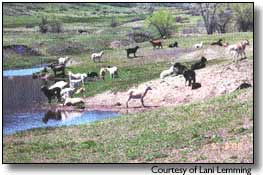|
July 14, 2001
By Janelle Holden Socrates died of eating poison hemlock, but Lani Lamming’s goats love it. On a daily basis, her 2,000 Cashmere goats annihilate even the most toxic, noxious, and prickly of weeds — and they get paid to do it. Lamming, founder of Ewe4ic Ecological Services in Alpine, Wyo., spoke in Cortez on Wednesday at the Mancos and Dolores soil conservation districts’ workshop. "We’re not just goat-herders," Lamming told the crowd while showing slides of the work her goats have done in seven states. Lamming, her husband Fred, and her sons Reggie and Donny Benz have developed a profitable, environmentally sound alternative to the normal practice of controlling noxious weeds with pesticides — goats. A former cattle rancher, Lamming obtained a master’s degree in weed science at Colorado State University, where she conducted research on how sheep eat weeds. Her research led her to goats, which eat more types of weeds at a faster pace than sheep. After graduating from CSU, Lamming bought 100 Cashmere goats, and has built the herd to 2,000 over the four years she has been selling their services to landowners with weed-infested properties. As in Montezuma County, weeds are a problem across the western United States. Invasive species of non-native weeds take over 4,600 acres of land per day, and 1.5 million acres per year. They destroy habitat for native animals, increase erosion, create fire hazards, and decrease the value of land. Many states, counties, and cities mandate that landowners control noxious weeds on their property. Unlike cattle and horses, goats prefer weeds over lush grasses. As Lamming’s slides showed, goats eat the flower, then the leaves, and finally the prickly stalks of weeds as if they were the choicest kind of ice cream. Goats can also reach the more difficult places where weeds grow — in the tops of trees, cracks of rocks, on steep hillsides, underneath bridges and highway overpasses, and just about anywhere else. Its hard to believe, but with intensive grazing over several years, goats can decimate even the most aggressive of weeds, including leafy spurge, purple loosestrife, and musk thistle. "The weeds are smarter than the plants, the goats are smarter than the weeds, and the only thing smarter than the goats is a border collie," said Lamming. She has never advertised her service, but through word of mouth has managed to build a lucrative business. Her favorite question from awed spectators is often, "Is them your sheep?" So far her employers have included the city of Denver, the towns of Meeker and Parker, and the Vail and Breckenridge resorts as well as public-land managers across several states. Lamming used to charge by the acre to undercut the price of spraying herbicides on weeds, but now charges per head from 25 cents to $2 per day, plus the costs of trucking to the site. Lamming doesn’t own land, and has never had to buy feed or supplements for her goats. She hauls them in the middle of the night, and pens them in with the weeds with portable electric fences. "I think goats like to move," said Lamming. "They’re happy when they’re moving." Goats will eat weeds at any time of the year, and Lamming said the best time for grazing is in the fall and winter when the weeds are down. When the goats have finished their assignment, Lamming reseeds the newly turned soil with natural grasses fertilized by the goats’ waste. Any extra "fertilizer" is bagged and sold to organic farmers. The waste is not contaminated with seeds because of the unique shape of goats’ mouths and their powerful digestive enzymes. Lamming said any type of goat will eat weeds, but she chose Cashmere because of their "handleability" and wool product. The cashmere from the goats is hand-combed out and sold for $15 an ounce. Wednesday’s workshop was funded by the Colorado Grazing Land Conservation Incentive Committee. Lani Lamming can be reached at P.O. Box 3253, Alpine, WY 83128, by phone at (307) 654-7866 or e-mail ewe4icbenz@aol.com. |
||
|
Copyright © 2001 the Cortez Journal.
All rights reserved. |
